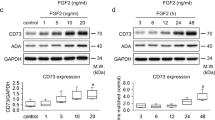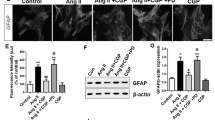Abstract
Previously, we showed in cultured rat astrocytes that angiotensin (Ang) III induced astrocyte proliferation and phosphorylation of ERK1/2 mitogen activated protein (MAP) kinases through interaction with the AT1 receptor. In the current study, we determined whether the c-Jun N terminal kinase (JNK) MAP kinase pathway was similarly affected by the peptide in cultured brainstem astrocytes. Ang III induced JNK phosphorylation in a concentration- and time-dependent manner. Similar to ERK1/2 phosphorylation, maximal phosphorylation occurred with 100 nM Ang III and was apparent within a minute of exposure to the peptide. Peak effects were observed over a 5–15 min time range. Pretreatment of brainstem astrocytes with the JNK inhibitor, SP600125, prevented Ang III phosphorylation of JNK, as well as Ang III-mediated astrocyte growth. The selective AT1 receptor antagonist, Losartan, prevented Ang III-induced JNK phosphorylation. Pretreatment of astrocytes with the AT2 receptor blocker PD123319 was ineffective in preventing JNK phosphorylation by Ang III. Interestingly, both Ang II and Ang III induced JNK phosphorylation to a similar extent suggesting that the two peptides were equipotent in this effect. Our findings suggest that Ang III interacts with Ang AT1 receptors to directly stimulate the JNK MAP kinase pathway leading to astrocyte growth. This study is the first to show that Ang III actions may involve the JNK MAP kinase pathway in astrocytes and provide key information that may lead to a better understanding of the functions of Ang III in the central nervous system, in particular in astrocytes.



Similar content being viewed by others
References
Abhold RH, Sullivan MJ, Wright JW, Harding JW (1987) Binding, degradation and pressor activity of angiotensins II and III after aminopeptidase inhibition with amastatin and bestatin. J Pharmacol Exp Ther 242:957–962
Antonyak MA, Kenyon LC, Godwin AK, James DC, Emlet DR, Okamoto I, Tnani M, Holgado-Madruga M, Moscatello DK, Wong AJ (2002) Elevated JNK activation contributes to the pathogenesis of human brain tumors. Oncogene 21:5038–5046
Bader M, Peters J, Baltatu O, Muller DN, Luft FC, Ganten D (2001) Tissue renin-angiotensin systems: new insights from experimental animal models in hypertension research. J Mol Med 79:76–102
Blair-West JR, Carey KD, Denton DA, Madden LJ, Weisinger RS, Shade RE (2001) Possible contribution of brain angiotensin III to ingestive behaviors in baboons. Am J Physiol 281:R1633–R1636
Blume A, Undeutsch C, Zhao Y, Kaschina E, Culman J, Unger T (2005) ANG III induces expression of inducible transcription factors of AP-1 and Krox families in rat brain. Am J Physiol 289:R845–R850
Campos LA, Bader M, Baltatu OC (2011) Brain Renin-Angiotensin system in hypertension, cardiac hypertrophy, and heart failure. Front Physiol 2:115
Chen CY, Huang WC (2000) Pressor and renal effects of intracerebroventricularly administered angiotensins II and III in rats. Kidney Blood Press Res 23:95–105
Clark MA, Gonzalez N (2007) Angiotensin II stimulates rat astrocyte mitogen-activated protein kinase activity and growth through EGF and PDGF receptor transactivation. Regul Pept 144:115–122
Clark MA, Gonzalez N (2007) Src and Pyk2 mediate angiotensin II effects in cultured rat astrocytes. Regul Pept 143:47–55
Clark MA, Guillaume G, Pierre-Louis HC (2008) Angiotensin II induces proliferation of cultured rat astrocytes through c-Jun N-terminal kinase. Brain Res Bull 75:101–106
Clark MA, Tran H, Nguyen C (2011) Angiotensin III stimulates ERK1/2 mitogen-activated protein kinases and astrocyte growth in cultured rat astrocytes. Neuropeptides 45:329–335
Fleegal MA, Sumners C (2003) Angiotensin II induction of AP-1 in neurons requires stimulation of PI3-K and JNK. Biochem Biophys Res Commun 310:470–477
Freeman EJ, Chisolm GM, Ferrario CM, Tallant EA (1996) Angiotensin-(1–7) inhibits vascular smooth muscle cell growth. Hypertension 28:104–108
Gammelgaard I, Wamberg S, Bie P (2006) Systemic effects of angiotensin III in conscious dogs during acute double blockade of the renin-angiotensin-aldosterone-system. Acta Physiol (Oxf) 188:129–138
Harding JW, Felix D, Sullivan MJ, Camara CA, Erickson JB, Regulja I, Abhold RF, Wright JW (1987) The pivotal role at angiotensin III in the brain angiotensin system. Proc West Pharmacol Soc 30:11–15
Hus-Citharel A, Iturrioz X, Corvol P, Marchetti J, Llorens-Cortes C (2006) Tyrosine kinase and mitogen-activated protein kinase/extracellularly regulated kinase differentially regulate intracellular calcium concentration responses to angiotensin II/III and bradykinin in rat cortical thick ascending limb. Endocrinology 147:451–463
Johnson A, Thunhorst RL (1995) Sensory mechanisms in the behavioral control of body fluid balance: thirst and salt appetite. Academic Press, New York
Karin M, Gallagher E (2005) From JNK to pay dirt: jun kinases, their biochemistry, physiology and clinical importance. IUBMB Life 57:283–295
Mahesh VB, Dhandapani KM, Brann DW (2006) Role of astrocytes in reproduction and neuroprotection. Mol Cell Endocrinol 246:1–9
Marc Y, Llorens-Cortes C (2011) The role of the brain renin-angiotensin system in hypertension: implications for new treatment. Prog Neurobiol 95:89–103
McKinley MJ, Albiston AL, Allen AM, Mathai ML, May CN, McAllen RM, Oldfield BJ, Mendelsohn FA, Chai SY (2003) The brain renin-angiotensin system: location and physiological roles. Int J Biochem Cell Biol 35:901–918
Mukoyama M, Nakajima M, Horiuchi M, Sasamura H, Pratt RE, Dzau VJ (1993) Expression cloning of type 2 angiotensin II receptor reveals a unique class of seven-transmembrane receptors. J Biol Chem 268:24539–24542
Murphy TJ, Alexander RW, Griendling KK, Runge MS, Bernstein KE (1991) Isolation of a cDNA encoding the vascular type-1 angiotensin II receptor. Nature 351:233–236
Pawate S, Bhat NR (2006) C-Jun N-terminal kinase (JNK) regulation of iNOS expression in glial cells: predominant role of JNK1 isoform. Antioxid Redox Signal 8:903–909
Raizada MK, Phillips MI, Crews FT, Sumners C (1987) Distinct angiotensin II receptor in primary cultures of glial cells from rat brain. Proc Nat Acad Sci USA 84:4655–4659
Raizada MK, Rydzewski B, Lu D, Sumners C (1993) Angiotensin II type 1 receptor-mediated stimulation of c-fos gene expression in astroglial cultures. Am J Physiol 265:C1046–C1049
Reaux-Le Goazigo A, Iturrioz X, Fassot C, Claperon C, Roques BP, Llorens-Cortes C (2005) Role of angiotensin III in hypertension. Curr Hypertens Rep 7:128–134
Reaux A, Fournie-Zaluski MC, Llorens-Cortes C (2001) Angiotensin III: a central regulator of vasopressin release and blood pressure. Trends Endocrinol Metab 12:157–162
Reid IA (1992) Interactions between ANG II, sympathetic nervous system, and baroreceptor reflexes in regulation of blood pressure. Am J Physiol 262:E763–E778
Ruiz-Ortega M, Lorenzo O, Egido J (2000) Angiotensin III increases MCP-1 and activates NF-kappaB and AP-1 in cultured mesangial and mononuclear cells. Kidney Int 57:2285–2298
Shenoy UV, Richards EM, Huang XC, Sumners C (1999) Angiotensin II type 2 receptor-mediated apoptosis of cultured neurons from newborn rat brain. Endocrinology 140:500–509
Stornetta RL, Hawelu-Johnson CL, Guyenet PG, Lynch KR (1988) Astrocytes synthesize angiotensinogen in brain. Science 242:1444–1446
Tallant EA, Diz DI, Ferrario CM (1996) Identification of AT1 receptors on cultured astrocytes. Adv Exp Med Biol 396:121–129
Tallant EA, Higson JT (1997) Angiotensin II activates distinct signal transduction pathways in astrocytes isolated from neonatal rat brain. Glia 19:333–342
Tseng CJ, Chou LL, Ger LP, Tung CS (1994) Cardiovascular effects of angiotensin III in brainstem nuclei of normotensive and hypertensive rats. J Pharmacol Exp Ther 268:558–564
Wang HX, Zhang QF, Zeng XJ, Wang W, Tang CS, Zhang LK (2010) Effects of angiotensin III on protein, DNA, and collagen synthesis of neonatal cardiomyocytes and cardiac fibroblasts in vitro. J Cardiovasc Pharmacol Ther 15:393–402
Wang Y, Luo W, Stricker R, Reiser G (2006) Protease-activated receptor-1 protects rat astrocytes from apoptotic cell death via JNK-mediated release of the chemokine GRO/CINC-1. J Neurochem 98:1046–1060
Wilson WL, Roques BP, Llorens-Cortes C, Speth RC, Harding JW, Wright JW (2005) Roles of brain angiotensins II and III in thirst and sodium appetite. Brain Res 1060:108–117
Xue B, Johnson AK, Hay M (2007) Sex differences in angiotensin II- induced hypertension. Braz J Med Biol Res 40:727–734
Yang CC, Chan JY, Chan SH (1995) Central effect of angiotensin III on caudal hypoglossal neurons in rats. Am J Physiol 268:R1242–R1248
Yatabe J, Yoneda M, Yatabe MS, Watanabe T, Felder RA, Jose PA, Sanada H (2011) Angiotensin III stimulates aldosterone secretion from adrenal gland partially via angiotensin II type 2 receptor but not angiotensin II type 1 receptor. Endocrinology 152:1582–1588
Zini S, Fournie-Zaluski MC, Chauvel E, Roques BP, Corvol P, Llorens-Cortes C (1996) Identification of metabolic pathways of brain angiotensin II and III using specific aminopeptidase inhibitors: predominant role of angiotensin III in the control of vasopressin release. Proc Nat Acad Sci USA 93:11968–11973
Acknowledgments
This work was supported by a President’s Faculty Research & Development Grant from Nova Southeastern University. The authors would like to thank pharmacy students Larisa Odessky and Jenny Estrin for their excellent technical assistance.
Author information
Authors and Affiliations
Corresponding author
Rights and permissions
About this article
Cite this article
Clark, M.A., Nguyen, C. & Tran, H. Angiotensin III Induces c-Jun N-terminal Kinase Leading to Proliferation of Rat Astrocytes. Neurochem Res 37, 1475–1481 (2012). https://doi.org/10.1007/s11064-012-0738-9
Received:
Revised:
Accepted:
Published:
Issue Date:
DOI: https://doi.org/10.1007/s11064-012-0738-9




